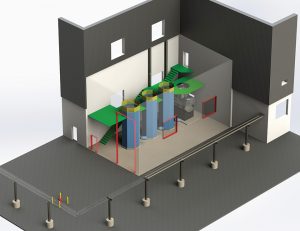What if students in capstone design classes completed structural designs for real sites, interacted with a real client, and added value for future construction?
In undergraduate education, structural capstone designs are usually retrospective or invented, even when planned for a real site. Universities create competitive design climates, even incorporating virtual reality into capstone design courses. Some universities invite practitioners to judge the students’ design presentations. However, the projects are not constructed. The students know that the project will never be constructed: it is just about learning and, ultimately, a grade.
An alternative is illustrated by the civil engineering capstone design class at the University of Missouri-Kansas City (UMKC), which has incorporated real general civil engineering projects into capstone classes since 2003 and real structural engineering projects since 2016. The classes frequently and spontaneously engage in discussions and analysis of registration and ethics. The practitioners and faculty are quite transparent about their opinions, experience, and limitations. Ashraf Habibullah’s dream for the future of structural engineers is shared with the design teams. The capstone students at UMKC have the professional satisfaction of knowing that their project is of real value to the client.

2017-18 structural engineering student design recommendation for boiler enclosure at KCP&L location.
The capstone design class is a two-semester studio class where students work in teams of 6-8 with a practitioner (P.E.) on small projects for area municipalities and other clients. In the fall semester, the students define their project scope and present their design options and budget at the client’s site (city hall, corporate headquarters, etc.) as both a presentation and a design report. Over the winter break, the client decides which design options they want to be developed; in the spring semester, the students develop 30% construction drawings. Typical general civil projects have included intersection improvements, urban stormwater improvements, and rural box culvert replacements. All students attend an engineering public meeting and learn about easements, rights-of-way, utility conflicts, and interactions with the public. There are very few traditional classroom events as part of the course – it is almost entirely a studio class.
A recent alumnus, working in a structural design firm, was asked for his advice on project components for a structural engineering capstone. His suggestions have been incorporated into the structural projects:
- Determine the loading in the structure (ASCE 7, IBC)
- Include references to codes in the client’s report
- Include design process justification in the report
- Use a commercial structural analysis program
- Provide load calculations in the report to the client
- Include structural connections in the drawing set
A right-sized structural design project was volunteered by Kansas City Power & Light (KCP&L), a power generating and distribution company in western Missouri and eastern Kansas. Jim Palmer, P.E., is the program manager of the KCP&L central engineering program and the practitioner for the structural capstone group. The “Redcone Project” reinforces personal, professional responsibility and the consequences of engineering actions because it is a real project for an actual client.
The 2016-2017 project was a 45- x 45-foot enclosure for fly ash loading under an existing fly ash silo. The project also included identifying a dust control system and designing the deck on which the equipment would sit above the trucks. The students had to consider the truck driver’s safety and create an enclosure that would be robust enough to use a skid steer to remove accumulated fly ash inside the enclosure while choosing an easily maintainable external material. The group also recommended rubber overhead doors that would re-seat themselves if hit by a truck and a dust suppression system for the enclosure. Their design calculations cited the AISC Steel Construction Manual, IBC, ASCE 7, and LFRD Load Combinations.
The 2017-2018 project is a design for the demolition and relocation of existing components of a boiler building, and a 31- x 55-foot enclosure that would house new auxiliary boilers. The project team created designs utilizing a variety of materials including concrete, steel, masonry, and precast/prefabricated options. The design incorporated building codes for personnel egress with fire protection, including a firewall.
The structural design project completed by the UMKC students is of real value to KCP&L. General civil projects are usually built (as designed by the students) by in-house construction staff at the municipalities, or redrawn and stamped at the DOT. For KCP&L, the structural project group creates a technical concept study for the company’s budgeting and long-range planning, which will help the company create bid documents for construction.
The role of the practitioner within the classroom is central to the success of the course. Ultimately, these practitioners are responsible for keeping the students within scope, maintaining focus, ensuring quality, and providing professional mentorship. The practitioners ensure student ownership of the project by using their expertise to provide guidance, not direction, to the university, students, client, and the workforce. The practitioners in the UMKC capstone class meet weekly with their design group, so full support from their employers is essential.
The structural capstone design project applies to universities that a) have a relationship with a client who needs small, structural improvements to their property, such as a power company; and b) have a structural engineer who can mentor the students through the design. The authors encourage fellow civil and structural engineering design departments to consider including a real project-based structural capstone design option that will satisfy the students and better prepare them for professional practice.▪
